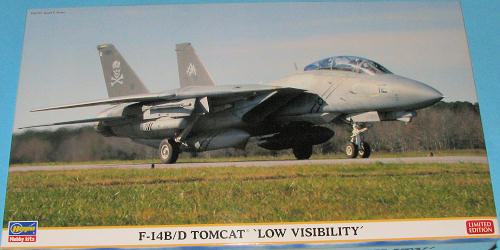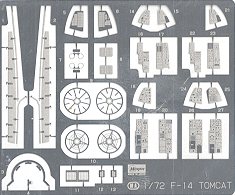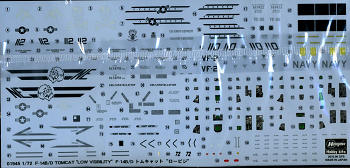
Hasegawa 1/72 F-14B/D Tomcat 'Low Visibility'
| KIT #: | 01945 |
| PRICE: | $42.35 from www.greatmodels.com ($53.00 SRP) |
| DECALS: | Two options |
| REVIEWER: | Scott Van Aken |
| NOTES: | 2010 Limited reissue |

| HISTORY |
When the Tomcat was first built, it used the same TF-30 engine as used in the F-111. It soon became obvious that this engine was not able to fully take advantage of the Tomcat airframe and soon Grumman developed the F-14B with the same GE engine used in some F-16Cs. While the engine was what the Tomcat really needed, the funding was not there so the project was put on the back burner. Eventually, the loot was available and so began what was know as the F-14A+ with this new engine. Later it was redesignated F-14B. The final variant of the F-14 was the F-14D Super Tomcat. The F-14D variant was first delivered in 1991. The original F-14A engines replaced with GE F110-400 engines, similar to the F-14B. The F-14D also included newer digital avionics systems including a Glass cockpit and replaced the AWG-9 with the newer AN/APG-71 radar. Other systems included the Airborne Self Protection Jammer (ASPJ), Joint Tactical Information Distribution System (JTIDS), SJU-17(V) Naval Aircrew Common Ejection Seats (NACES) and Infrared Search and Track (IRST).
Although the F-14D was to be the definitive version of the Tomcat, not all fleet units received the D variant. In 1989, Secretary of Defense Dick Cheney refused to approve the purchase of any more F-14D model aircraft for $50 million each and pushed for a $25 million modernization of the F-14 fleet instead. Congress decided not to shut production down and funded 55 aircraft as part of a compromise. A total of 37 new aircraft were constructed and 18 F-14A were upgraded to D variants (these were designated as F-14D(R). The R was for rebuild. An upgrade to the F-14D's computer software to allow AIM-120 AMRAAM missile capability was planned but was later terminated.
While upgrades had kept the F-14 competitive with modern fighter aircraft technology, Cheney called the F-14 1960s technology. Despite some aggressive proposals from Grumman for a replacement, Cheney planned to replace the F-14 with a fighter that was not manufactured by Grumman. Cheney called the F-14 a "jobs program", and when the F-14 was canceled, an estimated 80,000 jobs of Grumman employees, subcontractors, or support personnel were affected.
Starting in 2005, some F-14Ds received theROVER III upgrade and were designated as F-14D(R). Of course, this designation only confused things with the rebuilt aircraft, however, since the system was only used for the F-14s final deployment, the whole thing is really moot.
| THE KIT |
Asdemanded, the panel lines are engraved and the kit offers the ability to havethe flaps and slats deployed. In fact, to do it otherwise will require a bit ofsurgery to be done on the slat tracks. You can also position the glove vanesopen or closed. Again, some surgery is needed for the closed position. All F-14shad them wired in the closed position after it was realized that they didn't really do anything and were an additional maintenance hassle. You also have the ability to have the speed brakes and entrance steps/ladderopen or closed, and two different tails, though one set is not for thisparticular boxing. So much has the F-14 been modified and updated over the yearsthat you really need to have photographs of the aircraft that you are modelingto get everything right.
 As required by its price, this kit comes with a small fret ofetched metal. These bits are for the interior, canopy and exhaust. The metalworkis very well done and should really enhance your Tomcat. For this kit, they supply an instruction sheet dedicated to this boxing rather than the usual F-14A instruction sheet and an addendum sheet that shows the B/D model differences. The instructions arevery well done as you would expect. They offer color callouts based on Gunzepaint as is the norm with Hasegawa over the last decades. Every option anddifference between the aircraft on the decal sheet is given so that you can do aproper job of things.
As required by its price, this kit comes with a small fret ofetched metal. These bits are for the interior, canopy and exhaust. The metalworkis very well done and should really enhance your Tomcat. For this kit, they supply an instruction sheet dedicated to this boxing rather than the usual F-14A instruction sheet and an addendum sheet that shows the B/D model differences. The instructions arevery well done as you would expect. They offer color callouts based on Gunzepaint as is the norm with Hasegawa over the last decades. Every option anddifference between the aircraft on the decal sheet is given so that you can do aproper job of things.
 For markings, we have options for two planes. One is an F-14B from VF-103 as shown on the box top. This is at least the fourth time this unit has been featured on a Hasegawa 1/72 Tomcat box. The grey fins will need to be painted using FS 36081. The second is an F-14D from VF-2. Both aircraft are in the tactical paint scheme. Decals are nicely done and provide all the data and intake walk areas. I am quite pleased that Hasegawa has their instructions in booklet form as it makes it much easier to deal with while building this kit. Hope it is a feature of things to come.
For markings, we have options for two planes. One is an F-14B from VF-103 as shown on the box top. This is at least the fourth time this unit has been featured on a Hasegawa 1/72 Tomcat box. The grey fins will need to be painted using FS 36081. The second is an F-14D from VF-2. Both aircraft are in the tactical paint scheme. Decals are nicely done and provide all the data and intake walk areas. I am quite pleased that Hasegawa has their instructions in booklet form as it makes it much easier to deal with while building this kit. Hope it is a feature of things to come.
| CONCLUSIONS |
You can add this one to a growing list of Hasegawa limited reissue kits. I guess it is a good way to do business as they seem to sell rather well. I'm surprised at how well these molds have held up. The final result of the build is a superb model of an important US fighter.
| REFERENCES |
http://en.wikipedia.org/wiki/F-14_Tomcat
October 2011
You can find this kit and many other neat kits at www.greatmodels.com .
If you would like your product reviewed fairly and fairly quickly, please contact the editor or see other details in the